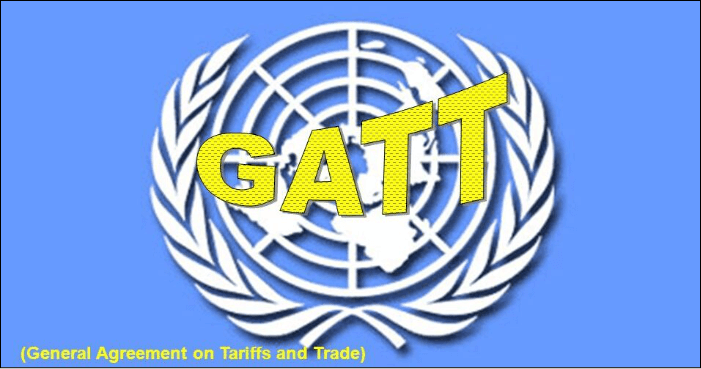General Agreement on Tariffs and Trade (GATT)What is GATT?The General Agreement on Tariffs and Trade (GATT), signed in 1947 by 23 nations, is a treaty that reduces trade barriers by removing or decreasing quotas, tariffs, and subsidies. GATT was established to remove protectionism, promote free trade among nations, and restore economic prosperity; it was meant to help the economy recover after WWII. 
GATT was enlarged and modified over time, resulting in the World Trade Organization (WTO) establishment in 1995, which absorbed the organisation formed to implement GATT; by that time, 125 countries had ratified their accords, which encompassed around 90% of global trade. The Council for Trade in Goods (Goods Council) is currently in charge of overseeing the GATT and is made up of representatives from all WTO member nations; there are ten committees on the council that typically deal with issues such as anti-dumping measures, market access, and agriculture. Understanding the GATTThe GATT was formed to set regulations to remove or eliminate the priciest and most ineffective aspects of the pre-war protectionist era, particularly quantitative trade barriers like trade controls and quotas. The pact also included a system for resolving economic disputes among nations, and the framework allowed for a series of multilateral negotiations to reduce tariff barriers. The GATT was viewed as a tremendous success in the post-war period. The GATT's goal of promoting discrimination-free trade was one of its major accomplishments. Every GATT signatory member had to be treated equally with all others, and this is known as the most-favoured-nation principle, and it's been carried through into the World Trade Organization. As a practical outcome, after a nation had agreed to decrease its tariffs with some other countries (typically those that were its most significant trading partners), the same reduction would automatically be applied to all GATT signatories. There were escape clauses, which allowed nations to negotiate exceptions if tariff cuts would significantly affect domestic producers; most countries used the most-favoured-nation principle in determining tariffs, which mainly superseded quotas. In turn, tariffs-which are preferable to quotas but are yet a trade barrier-were gradually reduced in rounds of successive negotiations. Objectives of GATTThe primary objectives/goals for which the GATT was formed include:
The negotiating and contracting parties to the General Agreement seek to further the goals mentioned above by establishing reciprocal and mutually beneficial trade agreements designed to significantly reduce tariffs and other trade restrictions and end discrimination in global trade. However, the GATT's articles don't offer instructions on how to achieve these goals. The GATT aimed to achieve its goals by fostering open/unrestricted and multilateral international trade. Fundamental PrincipleThe ultimate goal of GATT is to create a free multilateral trading system, liberalise trade internationally, end discrimination, and lower all forms of trade barriers. In order to achieve this goal, GATT has established a set of principles that restrict unfair trade practices and provide a code of conduct for all parties involved in trading activity. These are some of the fundamental principles:
Most-Favourable-Nation ClauseGATT participants concur that trade barriers should be reduced and discrimination eliminated in a way that benefits both parties. Members commit to giving each other unconditional most-favourable-nation treatment in all duties on imports and exports with some limitations in order to prevent discrimination. According to the most-favourable-nation concept, every country should be treated equally. Thus, the grant of any additional preference is prohibited by the contracting parties. Additionally, in order to make the concessions multilateral, all member nations should be treated equally in the negotiations and concessions that resulted from bilateral accords. It also means that no party should be favoured in the administration of the permissible quantitative constraints. Such limitations are only permitted by GATT for the following:
Additionally, GATT stipulates that state trading must be non-discriminatory. The General Agreement does, however, permit the creation of customs unions or free-trade zones as long as their main objective is to enhance commerce between the constituent countries and not to erect trade obstacles against other signatories. Tariff NegotiationsThe GATT acknowledges that tariffs are the main barriers preventing the expansion of global commerce. As a result, the contracting parties are permitted to negotiate periodically for a significant decrease in tariffs. The following guidelines should be adhered to when negotiating tariffs:
In order to negotiate a reduction in tariffs, the GATT used a bilateral-multilateral approach. It was a bilateral approach because nations were involved in nation-to-nation negotiations. In reality, the contracting parties created pairs, and each pair carried out discussions on a specific commodity-by-commodity basis. The "most-favoured-nation clause" was used to make the tariff reductions agreed upon between bilateral pairs of negotiating parties typically apply to all contracting parties, which gave the negotiations multilateral characteristics as well. The bilateral-multilateral tariff reduction strategy has the following disadvantages:
Drawbacks of GATT
GATT vs WTOThe WTO was built on the principles of the GATT. The 1947 pact itself is no longer in effect. Although it was intended to maintain trade agreements in place while the WTO was being established, its contents were integrated into the GATT 1994 agreement. As a result, the GATT of 1994 became a part of the WTO Agreement. Even though the GATT's objective was substantially achieved, it was said that its institutional framework lacked coherence. In short, it was a legal agreement that functioned as an international organisation. The WTO embraces the GATT's principles and is better equipped to implement them since, among other things, it is more powerful, has a quicker dispute resolution process, and is more knowledgeable about matters like intellectual property. |
 For Videos Join Our Youtube Channel: Join Now
For Videos Join Our Youtube Channel: Join Now
Feedback
- Send your Feedback to [email protected]
Help Others, Please Share









